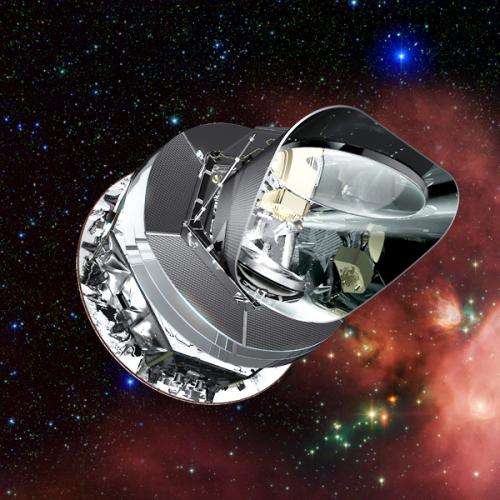December 4, 2014 report
Researchers report on data analysis from Planck spacecraft

(Phys.org)—A team of researchers analyzing data from a telescope aboard the European Space Agency's Planck spacecraft gave a presentation at Planck 2014 recently—a meeting held in a palace in Italy—to outline findings based on data from the spacecraft and also to discuss the implications of what has been found.
The spacecraft was active through the years 2009 through 2013, collecting data related to cosmic microwave background (CMB)—a type of radiation believed to have been a released during the latter part of the birth of the universe. Cosmologists and physicists in general are eager to learn more about the CMB because it helps tie together parts of the Standard Model.
Astrophysicist Nazzareno Mandolesi gave the general presentation including showing a map that depicts the direction and intensity of polarization of CMB as viewed in the full sky. He announced that observations from Planck reaffirm the standard model of cosmological inflation, but at the same time, call into question recent researchers' claims of having found evidence of dark matter.
Mandolesi reported that analysis of data from Planck doesn't support the idea that positron excess found during prior research might be generated by dark matter, nixing ideas some researchers had put forth. The data did however, offer further evidence that dark matter makes up approximately 26 percent of the mass of known universe. He noted also that the maps created using data from Planck offer more validation of inflation theory and as a bonus is also helping to clear up a mismatch between earlier data from the craft as compared with data from NASA's WMAP project.
Data from Planck also appears to show evidence that agrees with those who have theorized that stars formed roughly 700 to 800 million years after the birth of the Universe, rather than with those who suggest it was as low as 400 million years ago. Other data from the craft has been used to offer more evidence that neutrinos come in three flavors, which when taken with other evidence, Mandolesi noted, makes the idea of a fourth type of neutrino less likely.
The European Space Agency also announced at the meeting that they will be making the full Planck dataset available online beginning December 22nd.
More information: www.cieffeerre.it/Eventi/event … ure-and-polarization
© 2014 Phys.org

















